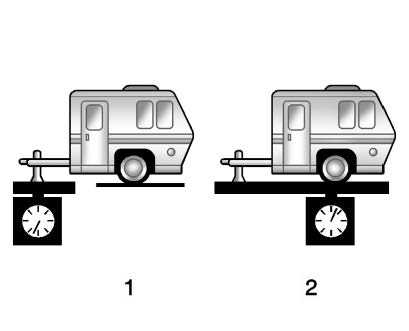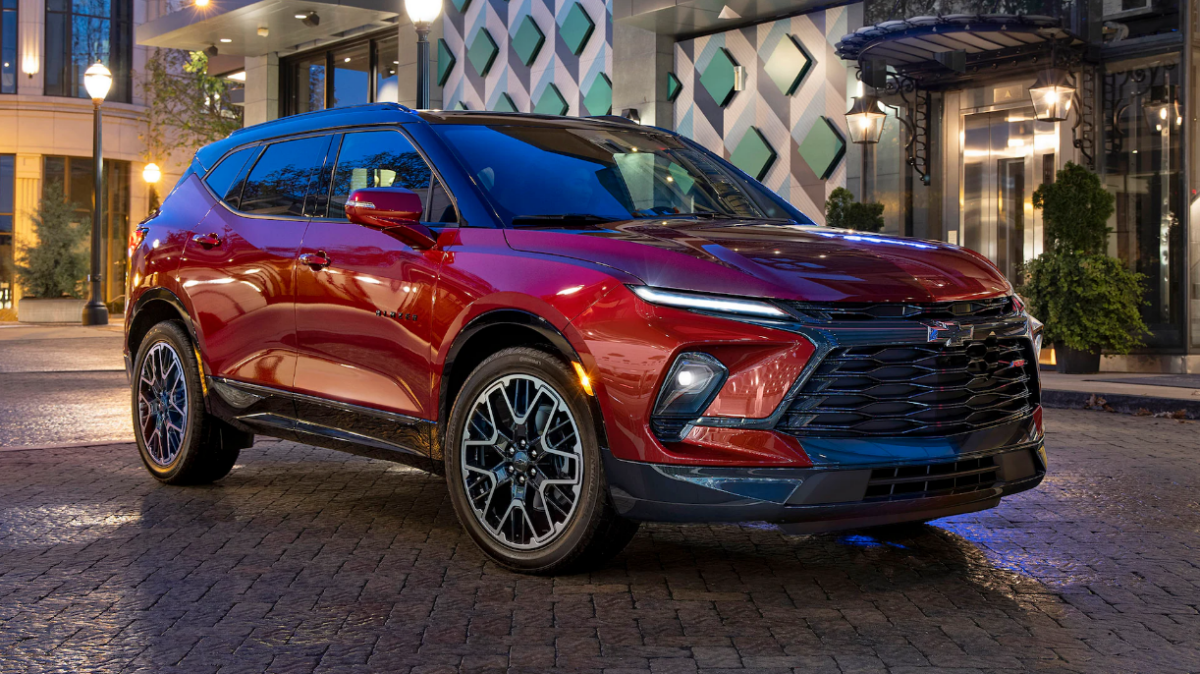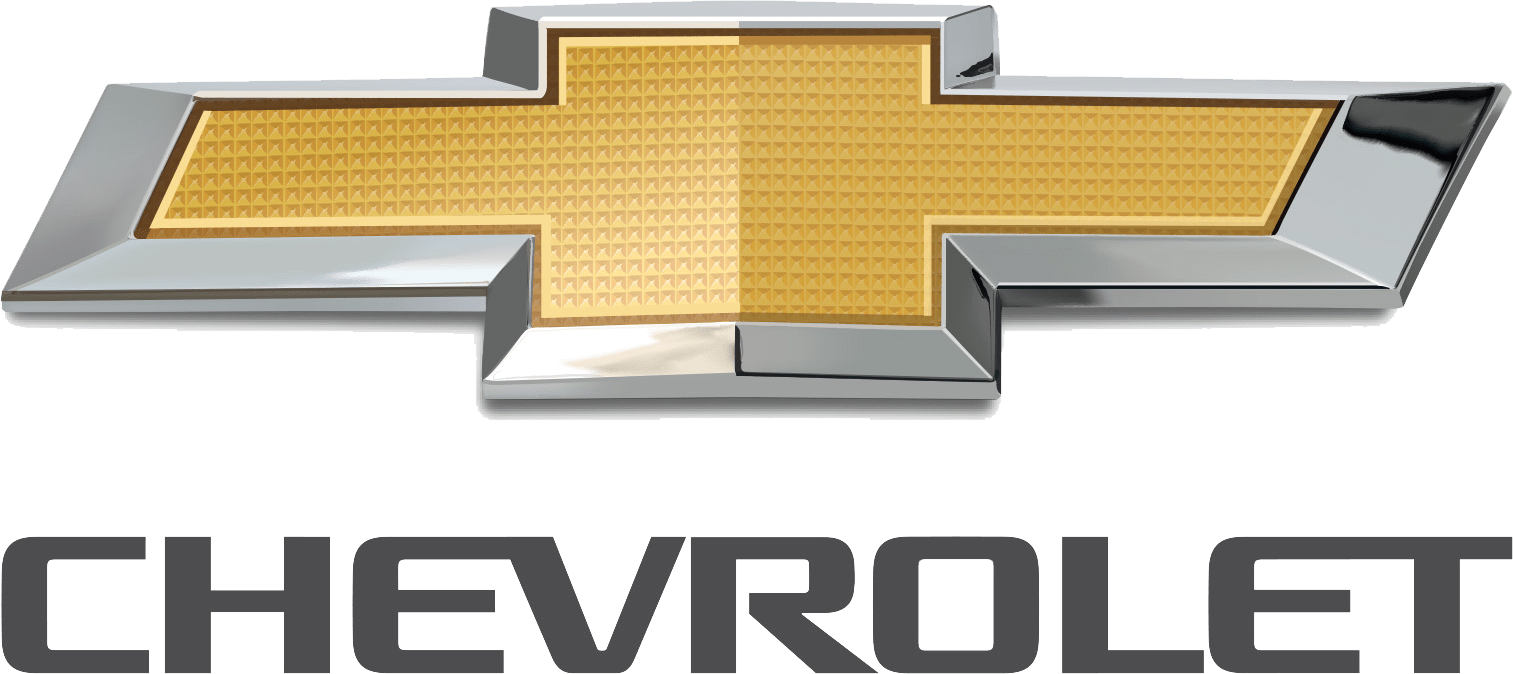2023 Chevrolet Blazer Trailer Load Balancing | Towing Owner’s Manual
A sophisticated trailer load balancing system that improves towing capacity and safety is available on the 2023 Chevrolet Blazer. This cutting-edge innovation makes towing stable and seamless, which makes it perfect for pulling trailers of all sizes. Drivers can feel more confident on the road as the Chevy Blazer 2023 optimizes performance when towing by automatically altering engine power and brake pressure. Blazer’s Trailer Load Balancing system adjusts to various loads and road conditions, making driving smooth whether you’re towing a utility trailer, boat, or camper. For individuals who need dependable and effective towing solutions, the Chevrolet Blazer 2023 is a great option because of its sophisticated towing capabilities, which establish a new benchmark in trailer load management. Every time you hit the road, you can be assured of a safe and controlled towing experience thanks to the Blazer’s Trailer Load Balancing system, which offers convenience and peace of mind.
2023 CHEVROLET BLAZER Specs, Price, Features, Mileage (Brochure)
Trailer Load Balance
The correct trailer load balance must be maintained to ensure trailer stability. Incorrect load balance is a leading cause of trailer sway.

- The trailer tongue weight (1) should be 10– 15% of the loaded trailer weight.
- Some specific trailer types, such as boat trailers, fall outside of this range. Always refer to the trailer owner’s manual for the recommended trailer tongue weight for each trailer. Never exceed the maximum loads for your vehicle, hitch, and trailer. After loading the trailer, separately weigh the trailer and then the trailer tongue and calculate the trailer load balance percentage to see if the weights and distribution are appropriate for your vehicle. If the trailer weight is too high, it may be possible to transfer some of the cargo into your vehicle. If the trailer tongue weight is too high or too low, it may be possible to rearrange some of the cargo inside of the trailer. Do not exceed the maximum allowable tongue weight for your vehicle. Use the shortest hitch extension available to position the hitch ball closer to your vehicle. This will help reduce the effect of the trailer tongue weight on the trailer hitch and the rear axle.
- If a cargo carrier is used in the trailer hitch receiver, choose a carrier that positions the load as close to the vehicle as possible. Make sure the total weight, including the carrier, is no more than half of the maximum allowable tongue weight for the vehicle or 227 kg (500 l b), whichever is less. Ask your dealer for trailering information or assistance.
Rear Gross Axle Weight Rating (GAWR-RR)
The GAWR-RR is the total weight that can be supported by the rear axle of the vehicle. Do not exceed the GAWR-RR for the vehicle, with the tow vehicle and trailer fully loaded for the trip including the weight of the trailer tongue. If using a weight-distributing hitch, do not exceed the GAWR-RR before applying the weight-distribution spring bars. For additional assistance with trailering or additional information, see your dealer.
2023 Blazer Towing Equipment User Manual Instructions
Towing Guide
Hitches
Always use the correct hitch equipment for your vehicle. Crosswinds, large trucks going by, and rough roads can affect the trailer and the hitch. Never attach rental hitches or other bumper-type hitches. Only use frame-mounted hitches that do not attach to the bumper.
Hitch Cover
To remove the hitch cover, if equipped:
- Remove the four fasteners on the lower tabs.
- Pull the lower edge of the cover to about a 45-degree angle.
- Pull the cover downward to disengage the upper attachments.
To reinstall the hitch cover: - Hold the cover at a 45-degree angle to the vehicle and push the upper tabs into the slots in the bumper.
- Push the bottom of the cover forward until the lower tabs line up with the lower slots.
- Snap the hitch cover into place by pushing the upper corners forward.
- Reinstall the four fasteners on the lower tabs.
Consider using mechanical sway controls with any trailer. Ask a trailering professional about sway controls or refer to the trailer manufacturer’s recommendations and instructions.
Weight-Distributing Hitch Adjustment
A weight-distributing hitch may be useful with some trailers.

- Front of the Vehicle
- Body-to-Ground Distance
- When using a weight-distributing hitch, measure the front fender height above the front axle distance
- before and after connecting the trailer. Adjust the spring bars until the front fender height distance
- is approximately halfway between the first and second measurements.
Chevrolet Blazer 2023 Towing Safety Tips
- Know Your Vehicle’s Towing Capacity: Before towing, familiarize yourself with your Chevrolet’s towing capacity. Exceeding this limit can lead to unsafe driving conditions.
- Properly Distribute Weight: Distribute the weight of the load evenly and secure it properly. An unevenly distributed load can cause instability and affect handling.
- Use the Right Equipment: Use a properly sized trailer hitch and ensure it is securely attached to your Chevrolet. Use safety chains and brake controllers as necessary.
- Check Trailer Lights and Brakes: Before towing, check that all trailer lights are working properly, including brake lights, turn signals, and running lights. Ensure the trailer brakes are functioning correctly.
- Inspect Tires: Check the tire pressure and condition of both your Chevrolet and the trailer tires before towing. Underinflated or worn tires can increase the risk of a blowout.
- Adjust Mirrors: Adjust your side mirrors and, if necessary, use towing mirrors to ensure you have a clear view of the trailer and surrounding traffic.
- Be Mindful of Speed: Reduce your speed when towing, especially when going uphill, downhill, or around curves. Avoid sudden manoeuvres or sharp turns.
- Allow for Extra Stopping Distance: Towing adds weight and momentum to your vehicle, so allow for extra stopping distance when braking. Start braking earlier than you normally would.
- Use Caution When Changing Lanes: Be cautious when changing lanes or passing other vehicles. Use your turn signals and check your blind spots carefully.
- Be Aware of Weather Conditions: Be mindful of weather conditions that may affect towing, such as strong winds, rain, or snow. Adjust your driving accordingly and consider delaying your trip if conditions are hazardous.
- Take Breaks: Take regular breaks during long trips to rest and stretch. Towing can be physically demanding, so listen to your body and avoid fatigue.
- Practice Backing Up: If you’re not experienced with towing, practice backing up with a trailer in a safe, open area before hitting the road.
2023 CHEVROLET BLAZER Specs, Price, Features, Mileage (Brochure)
2023 Chevy Blazer Tires
- Do not tow a trailer while using a compact spare tire on the vehicle.
- Tires must be properly inflated to support loads while towing a trailer.
- See Tires 0 277 for instructions on proper tire inflation.
Safety Chains
Always attach chains between the vehicle and the trailer, and attach the chains to the holes on the trailer hitch platform. Instructions for safety chains may be provided by the hitch manufacturer or by the trailer manufacturer. Cross the safety chains under the tongue of the trailer to help prevent the tongue from contacting the road if it becomes separated from the hitch. Always leave just enough slack so the combination can turn. Never allow safety chains to drag on the ground.
Trailer Brakes
Loaded trailers over 450 kg (1,000 lb) must be equipped with brake systems and with brakes for each axle. Trailer braking equipment conforming to Canadian Standards Association (CSA) requirement CAN3-D313, or its equivalent, is recommended. State or local regulations may require trailers to have their own braking system if the loaded weight of the trailer exceeds certain minimums that can vary from state to state. Read and follow the instructions for the trailer brakes so they are installed, adjusted, and maintained properly. Never attempt to tap into your vehicle’s hydraulic brake system. If you do, both the vehicle antilock brakes and the trailer brakes may not function, which could result in a crash.
Trailer Wiring Harness
Basic Trailer Wiring
The trailer wiring harness, with a seven-pin connector, is at the rear of the vehicle and is tied to the vehicle’s frame. The harness requires the installation of a trailer connector, which is available through your dealer. Use only a round, seven-wire connector with flat blade terminals meeting SAE J2863 specifications for proper electrical connectivity. The seven-wire harness contains the following trailer circuits:
- Yellow: Left Stop/Turn Signal
- Green: Right Stop/Turn Signal
- Brown: Tail/Parking Lamps
- White: Trailer Ground
- Red: Stop Lamp Supply Voltage
- Black: Back Up Lamp Supply Voltage
- Blue: Service Brakes
The fuse for the electric trailer brake circuit is in the engine compartment fuse block, but the wires may not be connected. They should be connected by your dealer or a qualified service center. To control electric trailer brakes, a trailer brake controller needs to be installed on the vehicle by your dealer or a qualified service center. See electric brake control wiring provisions. If a battery outside the vehicle is being charged, place the vehicle in Tow/Haul Mode. This will boost the vehicle system voltage and properly charge the battery. If the trailer is too light for Tow/Haul Mode, turn on the non-HID-only headlamps as a second way to boost the vehicle system voltage and charge the battery.
Electric Trailer Brake Control Wiring Provisions Wiring provisions for an aftermarket electric trailer brake controller are included with the vehicle as part of the trailer wiring package. The harness contains the following circuits: These wiring provisions for an electric trailer brake controller are included with the vehicle as part of the trailer wiring package. The body harness, inside the front driver-side instrument panel, contains blunt cut wires below the headlamp switch for the electric trailer brake controller.
The harness contains the following wires:
- Blue: Electric Trailer Brakes
- Blue: Battery Feed
- White/Blue: Brake Apply Signal
- Black: Ground
Refer to the aftermarket electric trailer brake controller owner’s manual to determine wire colour coding of the electric trailer brake controller. The wire colors on the brake controller may be different from the vehicle. The electric trailer brake controller should be installed by your dealer or a qualified service center.
Trailer Lamps
Always check all trailer lamps are working at the beginning of each trip, and periodically on longer trips.
Turn Signals When Towing a Trailer
When properly connected, the trailer turn signals will illuminate to indicate the vehicle is turning, changing lanes, or stopping. When towing a trailer, the arrows on the instrument cluster will illuminate even if the trailer is not properly connected or the bulbs are burned out.
Tow/Haul Mode
For instructions on how to enter Tow/Haul Mode, see Driver Mode Control 0 206. Tow/Haul assists when pulling a heavy trailer or a large or heavy load. See Driver Mode Control 0 206. Tow/Haul Mode is designed to be most effective when the vehicle and trailer combined weight is at least 75% of the vehicle’s Gross Combined Weight Rating. (GCWR). See “Weight of the Trailer” under.
Trailer Towing
Tow/Haul Mode is most useful when towing a heavy trailer or arraying a large or heavy load:
- Through rolling terrain.
- In stop-and-go traffic.
- In busy parking lots.
- Operating the vehicle in Tow/Haul Mode when lightly loaded or not towing will not cause damage; however, it is not recommended and may result in unpleasant engine and transmission driving characteristics and reduced fuel economy.
Trailer Sway Control (TSC)
Vehicles with StabiliTrak/Electronic Stability Control (ESC) have a Trailer Sway Control (TSC) feature. Trailer sway is the unintended side-to-side motion of a trailer while towing. If the vehicle is towing a trailer and the TSC detects that sway is increasing, the vehicle brakes are selectively applied at each wheel, to help reduce excessive trailer sway. If equipped with the Integrated Trailer Brake Control (ITBC) system, and the trailer has an electric brake system, StabiliTrak/ESC may also apply the trailer brakes.
If TSC is enabled, the Traction Control System (TCS)/StabiliTrak light will flash on the instrument cluster. Reduce vehicle speed by gradually removing your foot from the accelerator. If trailer sway continues, StabiliTrak/ESC can reduce engine torque to help slow the vehicle. TSC will not function if StabiliTrak/ESC is turned off. See Traction Control/Electronic Stability Control 0 204.
Warning
Trailer sway can result in a crash and in serious injury or death, even if the vehicle is equipped with TSC. If the trailer begins to sway, reduce vehicle speed by gradually removing your foot from the accelerator. Then pull over to check the trailer and vehicle to help correct possible causes, including an improperly or overloaded trailer, unrestrained cargo, and improper trailer hitch. configuration, or improperly inflated or incorrect vehicle or trailer tires. See Towing Equipment 0 241 for trailer ratings and hitch setup recommendations.
Trailer Tires
Special Trailer (ST) tires differ from vehicle tires. Trailer tires are designed with stiff sidewalls to help prevent sway and to support heavy loads. These features can make it difficult to determine if the trailer tire pressures are low only based on a visual inspection. Always check all trailer tire pressures before each trip when the tires are cool. Low trailer tire pressure is a leading cause of trailer tire blowouts. Trailer tires deteriorate over time. The trailer tire sidewall will show the week and year the tire was manufactured. Many trailer tire manufacturers recommend replacing tires more than six years old. Overloading is another leading cause of trailer tire blowouts. Never load your trailer with more weight than the tires are designed to support. The load rating is on the trailer tire sidewall. Always know the maximum speed rating for the trailer tires before driving. This may be significantly lower than the vehicle tire speed rating. The speed rating may be on the trailer tire sidewall. If the speed rating is not shown, the default trailer tire speed rating is 105 km/h (65 mph).
Conversions and Add-Ons
Add-On Electrical Equipment
The Data Link Connector (DLC) is used for vehicle service and Emission Inspection/ Maintenance testing. See Malfunction Indicator Lamp (Check Engine Light) 0 101. A device connected to the DLC — such as an aftermarket fleet or driver-behavior tracking device — may interfere with vehicle systems. This could affect vehicle.
Warning
Operation and cause a crash. Such devices may also access information stored in the vehicle’s systems.
Caution
Some electrical equipment can damage the vehicle or cause components to not work and would not be covered by the vehicle warranty. Always check with your dealer before adding electrical equipment. Add-on equipment can drain the vehicle’s 12-volt battery, even if the vehicle is not operating. The vehicle has an airbag system. Before attempting to add anything electrical to the vehicle, see Servicing the Airbag-Equipped Vehicle 0 60 and Adding Equipment to the Airbag-Equipped Vehicle 0 61.
FAQ’s
The 2023 Chevrolet Blazer has a maximum towing capacity that varies depending on the engine and towing package.
Proper load balancing when towing with the 2023 Chevrolet Blazer is crucial for safe and stable handling. Distribute the weight evenly across the trailer, ensuring the tongue weight is within the recommended range.
Tongue weight is the downward force exerted on the hitch ball by the trailer coupler. It’s important when towing with the 2023 Chevrolet Blazer as it affects the vehicle’s stability and handling. Proper tongue weight helps prevent sway and ensures safe towing.
Yes, the 2023 Chevrolet Blazer can be equipped with a towing package, which may include features such as a heavy-duty hitch, wiring harness, and trailer sway control system for enhanced towing capabilities.
The 2023 Chevrolet Blazer may offer various safety features for towing, including trailer sway control, integrated trailer brake controller, and rearview camera with trailer hitch guidance to assist with manoeuvring.
When towing with the 2023 Chevrolet Blazer, practice safe driving techniques such as maintaining a safe speed, allowing for longer braking distances, and being mindful of the increased length and weight of the vehicle-trailer combination.
The type of trailer brake system recommended for use with the 2023 Chevrolet Blazer may vary depending on the trailer’s weight and braking requirements.
Yes, you can install aftermarket towing accessories on the 2023 Chevrolet Blazer, but it’s essential to ensure compatibility and proper installation to maintain safe towing operations.
To determine if your trailer is within the towing capacity of the 2023 Chevrolet Blazer, calculate the total weight of the loaded trailer (including cargo) and ensure it does not exceed the maximum towing capacity specified for your vehicle.
Before towing with the 2023 Chevrolet Blazer, perform maintenance checks on essential components such as brakes, tires, lights, and trailer hitch to ensure they are in good working condition.
While towing with the 2023 Chevrolet Blazer, adhere to posted speed limits and avoid exceeding speeds that may compromise safety or stability, especially when towing heavy loads or driving in adverse conditions.
The ability to tow a camper or recreational vehicle (RV) with the 2023 Chevrolet Blazer depends on factors such as the vehicle’s towing capacity, hitching setup, and the weight of the camper or RV.
If you experience trailer sway while towing with the 2023 Chevrolet Blazer, ease off the accelerator, apply the trailer brakes independently (if equipped), and steer gently to regain control.
Familiarize yourself with local towing regulations and restrictions, including speed limits, trailer brake requirements, and weight restrictions, to ensure compliance when towing with the 2023 Chevrolet Blazer.
Useful Links
View Full User Guide: Chevrolet Blazer 2023 User Guide | Auto User Guide
2023 CHEVROLET BLAZER Specs, Price, Features, Mileage (Brochure)


